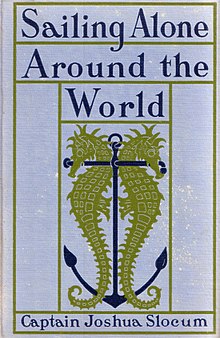
Circumnavigation is the complete navigation around an entire island, continent, or astronomical body. This article focuses on the circumnavigation of Earth.
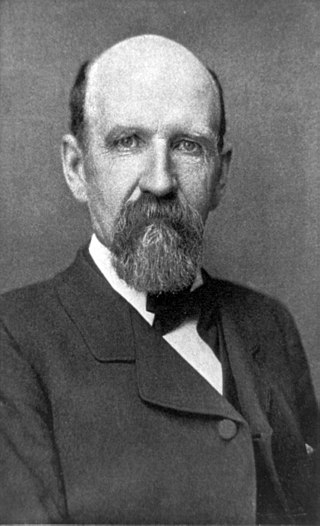
Joshua Slocum was the first person to sail single-handedly around the world. He was a Nova Scotian-born, naturalised American seaman and adventurer, and a noted writer. In 1900 he wrote a book about his journey, Sailing Alone Around the World, which became an international best-seller. He disappeared in November 1909 while aboard his boat, the Spray.

The Strait of Magellan, also called the Straits of Magellan, is a navigable sea route in southern Chile separating mainland South America to the north and Tierra del Fuego to the south. The strait is considered the most important natural passage between the Atlantic and Pacific oceans. It was discovered and first traversed by the Spanish expedition of Ferdinand Magellan in 1520, after whom it is named. Prior to this, the strait had been navigated by canoe-faring indigenous peoples including the Kawésqar.

The Victoria or Nao Victoria was a carrack famed as the first ship to successfully circumnavigate the world. Victoria was part of the Spanish expedition to the Moluccas commanded by the explorer Ferdinand Magellan until his death in the Philippines in 1521. The expedition began from Seville on 10 August 1519 with five ships and entered the ocean at Sanlúcar de Barrameda in Spain on September 20th. However, only two of the ships reached their goal in the Moluccas. Thereafter, Victoria was the only ship to complete the return voyage, crossing uncharted waters of the Indian Ocean under Juan Sebastián de Elcano's command to sail around the world. She returned to Sanlúcar on 6 September 1522.

Spray was a 36-foot-9-inch (11.20 m) sailboat weighing nine tons that Joshua Slocum, a 19th-century Canadian-American seaman and author, rebuilt and sailed around the world solo. On the morning of April 24, 1895, the Spray, with Slocum at the helm, departed Boston Harbor. On June 27, 1898, Slocum sailed the Spray into the harbor at Newport, Rhode Island, becoming the first man known to have sailed around the world alone.
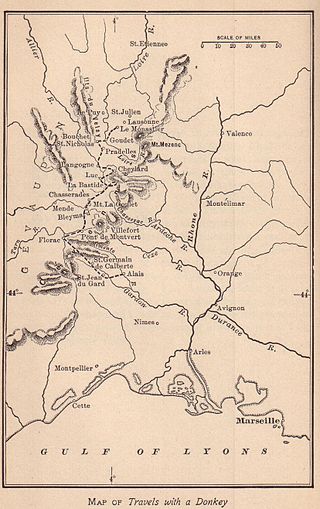
Outdoor literature is a literature genre about or involving the outdoors. Outdoor literature encompasses several different subgenres including exploration literature, adventure literature, mountain literature and nature writing. Another subgenre is the guide book, an early example of which was Thomas West's guide to the Lake District published in 1778. The genres can include activities such as exploration, survival, sailing, hiking, mountaineering, whitewater boating, geocaching or kayaking, or writing about nature and the environment. Travel literature is similar to outdoor literature but differs in that it does not always deal with the out-of-doors, but there is a considerable overlap between these genres, in particular with regard to long journeys.

Bernard Moitessier was a French sailor, most notable for his participation in the 1968 Sunday Times Golden Globe Race, the first non-stop, singlehanded, round the world yacht race. With the fastest circumnavigation time towards the end of the race, Moitessier was the likely winner for the fastest voyage, but he elected to continue on to Tahiti and not return to the start line in England, rejecting the idea of the commercialization of long distance sailing. He was a French national born and raised in Vietnam, then part of French Indochina.
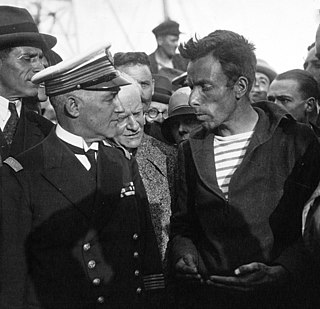
Alain Jacques Georges Marie Gerbault was a French Sailor, writer and tennis champion, who made a circumnavigation of the world as a single-handed sailor. He eventually settled in the islands of south Pacific Ocean, where he wrote several books about the islanders' way of life. As a tennis player he was ranked the fifth on the French rankings in 1923.
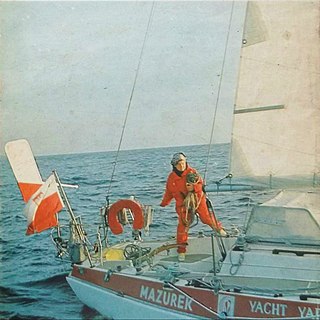
Krystyna Chojnowska-Liskiewicz was a Polish naval engineer and sailor as well as the first woman to have sailed single-handed around the world, repeating the accomplishment of Joshua Slocum. She sailed from the Canary Islands on 28 March 1976, and returned there on 21 April 1978, completing a circumnavigation of 31,166 nautical miles (57,719 km) in 401 days.
The sport and practice of single-handed sailing or solo sailing is sailing with only one crewmember. The term usually refers to ocean and long-distance sailing and is used in competitive sailing and among Cruisers.

The skipjack is a traditional fishing boat used on the Chesapeake Bay for oyster dredging. It is a sailboat which succeeded the bugeye as the chief oystering boat on the bay, and it remains in service due to laws restricting the use of powerboats in the Maryland state oyster fishery.

Cape Horn is the southernmost headland of the Tierra del Fuego archipelago of southern Chile, and is located on the small Hornos Island. Although not the most southerly point of South America, Cape Horn marks the northern boundary of the Drake Passage and marks where the Atlantic and Pacific Oceans meet.
Tania Aebi is an American sailor. She completed a solo circumnavigation of the globe in a 26-foot sailboat between the ages of 18 and 21, finishing it in 1987, making her the first American woman and the youngest person to sail around the world. Her record was not recognized by Guinness, because she sailed through the Panama Canal, which required assistance. She also sailed eighty miles with a friend in the South Pacific. Despite many challenges, Aebi accomplished her goal.

Teddy Seymour is the first black man to sail around the world solo.

The Magellan expedition, also known as the Magellan–Elcano expedition, was the first voyage around the world. It was a 16th-century Spanish expedition initially led by Portuguese explorer Ferdinand Magellan to the Moluccas, which departed from Spain in 1519, and completed in 1522 by Spanish navigator Juan Sebastián Elcano, after crossing the Atlantic, Pacific and Indian oceans, culminating in the first circumnavigation of the world.

Tilikum was a 38-foot (12 m) dugout canoe that was used in an effort to circumnavigate the globe starting in 1901. The boat was a "Nootkan" (Nuu-chah-nulth) canoe which was already old when she was obtained by captain John Voss in April 1901. The boat was built in the early 19th century as a dugout canoe made from a large red cedar log. Tilikum was purchased for $80 in silver from a native woman in a transference ceremony allegedly sealed by a bottle of rye whiskey - the name Tilikum means "friend" in Chinook jargon. Apparently, John Voss and his companion in this venture, Norman Luxton, were inspired by the voyage of Joshua Slocum, who sailed the 37-foot (11 m) sloop Spray around the world a few years earlier and wrote a best selling book about his adventures.
Edward Conor Marshall O'Brien was an Irish aristocrat and intellectual. His views were republican and nationalist. He was also owner and captain of one of the first boats to sail under the tri-colour of the Irish Free State. He was the first amateur Irish sailor to sail around the world.
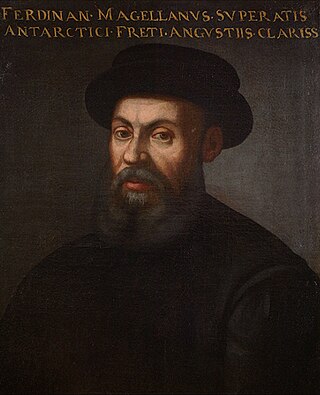
Ferdinand Magellan was a Portuguese explorer. He is best known for having planned and led the 1519 Spanish expedition to the East Indies across the Pacific Ocean to open a maritime trade route, during which he discovered the interoceanic passage bearing thereafter his name and achieved the first European navigation from the Atlantic to Asia.
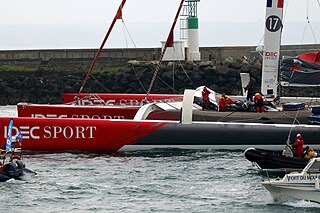
The first around the world sailing record for circumnavigation of the world was Juan Sebastián Elcano and the remaining members of Ferdinand Magellan's crew who completed their journey in 1522. The first solo record was set by Joshua Slocum in the Spray (1898).

The Magellan expedition, also known as the Magellan–Elcano expedition, was the first voyage around the world in human history. It was a Spanish expedition that sailed from Seville in 1519 under the initial command of Ferdinand Magellan, a Portuguese sailor, and completed in 1522 by Spanish Basque navigator Juan Sebastián Elcano.
